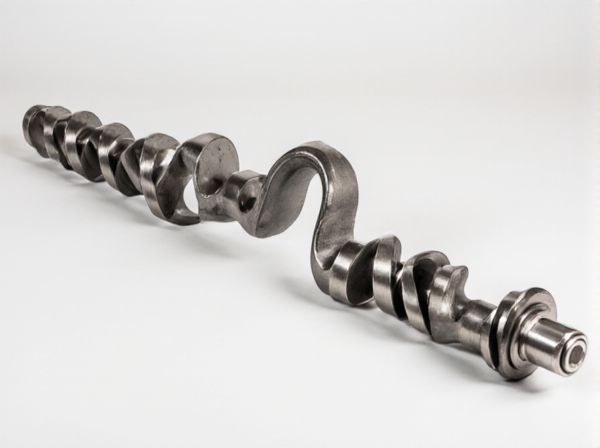
Photo illustration: Stroker vs Stock Stroke Crankshaft
A stroker crankshaft increases your engine's stroke length, boosting displacement and torque compared to a stock stroke crankshaft which maintains the original factory specifications. By extending the piston's travel within the cylinder, stroker crankshafts deliver enhanced power and improved engine performance. Choosing a stroker crankshaft is ideal if you want to maximize your engine's output beyond the stock limitations.
Table of Comparison
| Feature | Stroker Crankshaft | Stock Stroke Crankshaft |
|---|---|---|
| Stroke Length | Longer stroke than stock, increases displacement | Standard stroke length, factory specification |
| Engine Displacement | Increased displacement for higher torque and horsepower | Original displacement, designed for balance and reliability |
| Performance | Enhanced low-end torque, improved power output | Balanced performance, optimized for daily driving |
| Engine Stress | Higher stress on components, requires reinforced parts | Lower stress, compatible with stock engine components |
| Application | Performance builds, racing, and custom engines | Standard engines, OEM replacements |
| Cost | Generally higher due to modifications and materials | Lower, mass-produced and readily available |
Introduction to Stroker and Stock Stroke Crankshafts
Stroker crankshafts increase engine displacement by extending the crankshaft's stroke length beyond factory specifications, enhancing torque and horsepower. Stock stroke crankshafts maintain the original stroke dimension, preserving factory engine characteristics and ensuring reliability. Choosing between stroker and stock stroke crankshafts depends on the desired balance of performance, durability, and engine tuning goals.
Defining Stock Stroke: What Does It Mean?
Stock stroke refers to the original, manufacturer-specified distance a piston travels within the cylinder of an engine, typically designed for optimal balance between performance, reliability, and fuel efficiency. This measurement directly influences engine displacement and power output, maintaining the engine's intended mechanical characteristics without modifications. Understanding stock stroke is crucial when comparing it to stroker crankshafts, which alter this travel distance to increase displacement and enhance horsepower.
Understanding Stroker Crankshafts
Stroker crankshafts increase engine displacement by extending the piston's stroke length compared to stock stroke crankshafts, resulting in higher torque and horsepower output. They achieve this by increasing the crank throw radius, which moves the piston farther up and down within the cylinder bore, improving engine performance in applications requiring more low-end power. Understanding stroker crankshafts is essential for tuning and engine building, as their altered geometry affects compression ratios, piston positioning, and overall engine dynamics.
Key Differences Between Stroker and Stock Stroke Crankshafts
Stroker crankshafts increase engine displacement by extending the crankshaft's stroke length, enhancing torque and horsepower compared to stock stroke crankshafts that maintain factory specifications for reliability and longevity. The longer stroke in stroker crankshafts alters the engine's compression ratio and piston speed, often requiring customized components like pistons and rods to handle increased mechanical stress. Stock stroke crankshafts prioritize balance and OEM tolerances, making them ideal for everyday use, while stroker crankshafts target high-performance applications requiring improved power output and torque characteristics.
Performance Benefits of a Stroker Crankshaft
A stroker crankshaft increases engine displacement by extending the crank's stroke length, resulting in higher torque and improved low-end power compared to a stock stroke crankshaft. This enhanced displacement optimizes air-fuel combustion efficiency, leading to better overall engine performance and acceleration. Upgrading to a stroker crankshaft also allows for greater tuning flexibility and more substantial power gains in both naturally aspirated and forced induction setups.
Stock Stroke Crankshaft: Advantages and Applications
A stock stroke crankshaft maintains the engine's original stroke length, providing reliable performance and enhanced durability due to its factory-tested design. This type of crankshaft ensures optimal engine balance and smooth operation, reducing wear and increasing longevity in daily-driven vehicles and light-duty applications. Stock stroke crankshafts are commonly used in OEM replacements, mild performance upgrades, and restoration projects where maintaining engine reliability and emissions compliance is critical.
Potential Drawbacks of Choosing a Stroker Crankshaft
Choosing a stroker crankshaft increases engine displacement and power but may introduce potential drawbacks such as increased stress on engine components, leading to reduced longevity and higher maintenance costs. The longer stroke can cause greater piston speed, which elevates friction and heat, potentially compromising reliability at high RPMs. Additionally, the altered engine geometry often requires custom modifications to the block and internals, increasing complexity and build expenses.
Cost Comparison: Stroker vs Stock Stroke
Stroker crankshafts typically cost 25-40% more than stock stroke crankshafts due to increased machining, custom components, and higher-grade materials required for enhanced durability. While stock stroke crankshafts are mass-produced and more affordable, stroker variants demand precise engineering and often come with additional expenses such as aftermarket pistons and rods. Choosing a stroker crankshaft involves an upfront investment that supports higher horsepower and torque gains but may increase overall engine build costs by several hundred to over a thousand dollars compared to stock stroke setups.
Which Crankshaft Suits Your Engine Build?
Stroker crankshafts increase engine displacement by extending the piston's travel distance, resulting in higher torque and improved low-end power, ideal for performance builds requiring more grunt. Stock stroke crankshafts maintain the original engine specifications, offering reliability and efficiency suited for daily drivers or balanced builds prioritizing longevity. Choosing the right crankshaft depends on your engine goals: opt for stroker crankshafts for enhanced power output and customization, while stock stroke crankshafts suit engines focused on maintaining factory durability and fuel economy.
Conclusion: Making the Right Choice for Your Project
Choosing between a stroker and stock stroke crankshaft depends on your project goals: stroker crankshafts increase engine displacement and torque, enhancing power for performance builds, while stock stroke crankshafts maintain factory dimensions, offering reliability and simplicity for everyday use. A stroker crankshaft suits high-performance or racing engines where maximizing power output is critical, whereas a stock stroke crankshaft is ideal for budget builds, longevity, and straightforward maintenance. Evaluate factors such as desired horsepower gains, engine reliability, and project budget to make the most informed decision.
 caratoz.com
caratoz.com